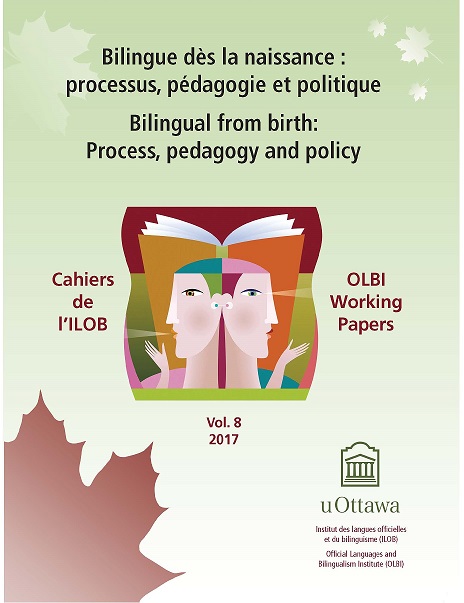How bilingual development is the same as and different from monolingual development
DOI :
https://doi.org/10.18192/olbiwp.v8i0.2114Mots-clés :
trajectoires bilingues, bilinguisme minoritaire vs. majoritaire, effets de l’intrant (input), effets de l’extrant (output)Résumé
À partir des données de deux études longitudinales menées sur des enfants âgés de 2 à 5 ans (un groupe de bilingues acquérant l’espagnol et l’anglais, et l’autre composé de monolingues anglais), nous comparons les processus et résultats de l’acquisition langagière bilingue simultanée face à son pendant monolingue. Il en résulte, essentiellement, que les processus sont identiques. En revanche, les résultats divergent en fonction des environnements immédiats du développement langagier — qu’il soit bilingue ou monolingue — et de contextes socioculturels plus larges. Les processus communs sont liés, d’une part, à la croissance langagière en matière de qualité et de quantité d’exposition, et, d’autre part, à la relation entre cette même croissance et l’usage que les enfants en font eux-mêmes. Les divergences en matière de résultats reposent sur les différences dans le taux de développement langagier et sur les profils de compétences expressives et réceptives des locuteurs.
Références
Bohman, T., Bedore, L.M., Peña, E.D., Mendez-Perez, A., & Gillam, R.B. (2010). What you hear and what you say: Language performance in Spanish English bilinguals. International Journal of Bilingual Education and Bilingualism, 13, 325–344. doi: 10.1080/13670050903342019
de Bot, K. (1996). The psycholinguistics of the output hypothesis. Language Learning, 46, 529–555. doi:10.1111/j.1467-1770.1996.tb01246.x
Brownell, R. (2000). Expressive One-Word Picture Vocabulary Test: Manual. Novato, CA: Academic Therapy Publications.
Brownell, R. (2001). Expressive One-Word Picture Vocabulary Test — Spanish–English Bilingual Edition. Novato, CA: Academic Therapy Publications.
Eilers, R.E., Pearson, B.Z., & Cobo-Lewis, A.B. (2006). Social factors in bilingual development: The Miami experience. In P. McCardle & E. Hoff (Eds.), Childhood bilingualism: Research on infancy through school age (pp. 68–90). Clevedon: Multilingual Matters.
Fenson, L., Dale, P.S., Reznick, J.S., Thal, D., Bates, E., Hartung, J.P., Pethick, S. & Reilly, J.S. (1993). The MacArthur Communicative Development Inventories: User’s guide and technical manual. San Diego: Singular Publishing Group.
Hart, B., & Risley, T.R. (1995). Meaningful differences in the everyday experience of young American children. Baltimore, MD: Paul H. Brookes Publishing.
Hoff, E., Core, C., Place, S., Rumiche, R., Señor, M., & Parra, M. (2012). Dual language exposure and early bilingual development. Journal of Child Language, 39, 1–27. doi:10.1017/S0305000910000759
Hoff, E., & Ribot, M. (2016). Trajectories of monolingual and bilingual development from 21/2 to 5 years. Unpublished manuscript.
Hoff, E., & Rumiche, R. (2012). Studying children in bilingual environments. In E. Hoff (Ed.), Research methods in child language: A practical guide (pp. 300– 316). Wiley-Blackwell.
Hoff, E., Rumiche, R., Burridge, A., Ribot, K.M., & Welsh, S.N. (2014). Expressive vocabulary development in children from bilingual and monolingual homes: A longitudinal study from two to four years. Early Childhood Research Quarterly, 29, 433–444. doi:10.1016/j.ecresq.2014.04.012
Huttenlocher, J., Haight, W., Bryk, A., Seltzer, M., & Lyons, T. (1991). Early vocabulary growth: Relation to language input and gender. Developmental Psychology, 27, 236–248. doi:10.1037/0012-1649.27.2.236
Jackson–Maldonado, D., Thal, D.J., Fenson, L., Marchman, V., Newton, T. & Conboy, B. (2003). El inventario del desarrollo de habilidades comunicativas: User’s guide and technical manual. Baltimore: Paul H. Brookes.
“Languages in Broward County, Florida (County)” (updated on Apr. 17, 2015, v1.0.9324:9326). Data from the US Census Bureau. statisticalatlas.com/county/Florida/Broward- County/Languages
Oller, D.K., & Eilers, R.E. (Eds.). (2002). Language and literacy in bilingual children (Vol. 2). Clevedon: Multilingual Matters.
Pearson, B.Z., Fernández, S.C., Lewedeg, V., & Oller, D.K. (1997). The relation of input factors to lexical learning by bilingual infants. Applied Psycholinguistics, 18, 41–58. doi:10.1017/S0142716400009863
Place, S., & Hoff, E. (2011). Properties of dual language exposure that influence 2-year-olds’ bilingual proficiency. Child Development, 82, 1834–1849. doi:10.1111/j. 1467-8624.2011.01660.x
Place, S. & Hoff, E. (2016). Effects and noneffects of input in bilingual environments on dual language skills in 21/2-year-olds. Bilingualism:
Language and Cognition, 19, 1023–1014. doi:10.1017/S1366728915000322
Ribot, K.M., & Hoff, E. (2014). “¿Cómo estas?” “I’m good.” Conversational code- switching is related to profiles of expressive and receptive proficiency in Spanish–English bilingual toddlers. International Journal of Behavioral Development, 38, 333–341. doi:10.1177/0165025414533225
Ribot, K.M., Hoff, E., & Burridge, A. (2017). Language use contributes to expressive language growth: Evidence from bilingual children. Child Development. doi: 10.1111/cdev.12770
Swain, M. (2005). The output hypothesis: Theory and research. In E. Hinkel (Ed.), Handbook of research in second language teaching and learning (pp. 292–299). Mahwah, NJ: Routledge.
Valdés, G. (2001). Heritage language students: Profiles and possibilities. In J.K. Peyton, D.A. Ranard, & S. McGinnis (Eds.), Heritage languages in America: Preserving a national resource. Language in education: Theory and practice (pp. 37–77). McHenry, IL: Delta Systems.
Zimmerman, I.L., Steiner, V.G., & Pond, R.E. (2002). Preschool Language Scale (4th ed.. San Antonio, TX: Harcourt Assessment.
Téléchargements
Publié-e
Numéro
Rubrique
Licence
Les auteurs qui publient avec Les Cahiers de l'ILOB acceptent les termes suivants:
- Les auteurs conservent le droit d'auteur et accordent à la revue le droit de première publication, l'ouvrage étant alors disponible simultanément, sous la licence Licence d’attribution Creative Commons permettant à d'autres de partager l'ouvrage tout en en reconnaissant la paternité et la publication initiale dans cette revue.
- Les auteurs peuvent conclure des ententes contractuelles additionnelles et séparées pour la diffusion non exclusive de la version imprimée de l'ouvrage par la revue (par ex., le dépôt institutionnel ou la publication dans un livre), accompagné d'une mention reconnaissant sa publication initiale dans cette revue.
- Les auteurs ne soumettront pas simultanément le même travail pour publication à plus d’une revue spécialisée à la fois.


